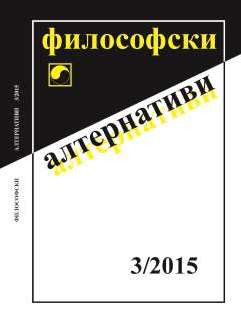Архитектура, урбанизъм, привидни закони
Architecture, Urbanism, Seeming Laws
Author(s): Todor TsigovSubject(s): Philosophy
Published by: Институт по философия и социология при БАН
Keywords: logoptics (author’s term); architecture; urbanism; real seeming laws; signal systems; traditional and trade culture; Bulgarian tradition.
Summary/Abstract: The article sums up the cultural context, including the Bulgarian one, of the author’s idea regarding an Orthodox analogue – logoptics/wordlook – of feng shui and vaastu. The facts have endless causes: the relations of the hypostases reflect the Universe, but we notice only the valences that concern us. A different interest would mark other valences/laws: facts. The respective behaviour links them to cultural identity. Architecture that accords with that behaviour suggests them figuratively. It is as if form introduces the real seeming laws into the functional past non-existence: imaginary stories (from which the form „follows”) continuing into the future. Thus, St. St. Cyril and Methodius created the Slavic-Bulgarian alphabet and the first translations from Greek of theosophical texts that had had almost two millennia of literary development by that time. In order to correspond to this literature, the Slavic- Bulgarian language was transformed in the course of translation in such a way that our culture continued to develop as if it had had a similar literary past: formal changes determining a more favourable alternative future and presetting the Bulgarian Renaissance. Thesis: the Second Signal System – language, reason – presupposes traditional culture, emphasizing the qualities and merits that stabilize society. The tradition is historical, and architecture corresponds to it: buildings emerge in time, forming figuratively a simultaneous diverse-time that reflects history, suggesting the respective qualities. Antithesis: money forms a Third Signal System, superimposed on the Second one and presupposing trade culture. The weaknesses (market requirements), stabilized technologically and financially, are emphasized. Urbanism, corresponding to money, plans (unlike architecture) the streets initially and builds the neighbourhoods according to a master plan. Not following history but the master plan, the buildings form not history’s simultaneous diverse-time but a timelessness, inhibiting the tradition, merits and qualities. However, trade culture does not endure the weaknesses eternally, which requires a new superstructure. Synthesis: the Fourth Signal System presupposes architectural-urban and psychic synthesis: by means of architecture, merits and qualities that overcome urbanism and weaknesses. Logoptics can be a Bulgarian practice for figurative stimulation of the future Fourth Signal System by means of an artificial living environment. Our National Revival ensembles have similar indications, conceptually described by architect Georgi Berberov as a double helix enfilade.
Journal: Философски алтернативи
- Issue Year: XXIV/2015
- Issue No: 3
- Page Range: 71-86
- Page Count: 16
- Content File-PDF

